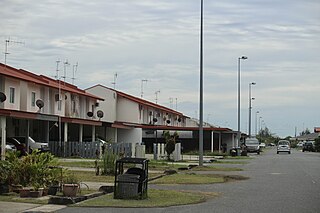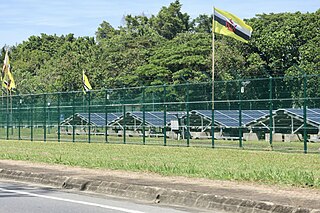
Electric power distribution is the final stage in the delivery of electricity. Electricity is carried from the transmission system to individual consumers. Distribution substations connect to the transmission system and lower the transmission voltage to medium voltage ranging between 2 kV and 33 kV with the use of transformers. Primary distribution lines carry this medium voltage power to distribution transformers located near the customer's premises. Distribution transformers again lower the voltage to the utilization voltage used by lighting, industrial equipment and household appliances. Often several customers are supplied from one transformer through secondary distribution lines. Commercial and residential customers are connected to the secondary distribution lines through service drops. Customers demanding a much larger amount of power may be connected directly to the primary distribution level or the subtransmission level.
Transpower New Zealand Limited (TPNZ) is the state-owned enterprise responsible for electric power transmission in New Zealand. It performs two major functions in the New Zealand electricity market. As the owner of the National Grid it provides the infrastructure of electric power transmission that allows consumers to have access to generation from a wide range of sources, and enables competition in the wholesale electricity market; as system operator it manages the real-time operation of the grid and the physical operation of the electricity market.

The electricity sector in Canada has played a significant role in the economic and political life of the country since the late 19th century. The sector is organized along provincial and territorial lines. In a majority of provinces, large government-owned integrated public utilities play a leading role in the generation, transmission, and distribution of electricity. Ontario and Alberta have created electricity markets in the last decade to increase investment and competition in this sector of the economy.

Panaga is a coastal settlement on the north-east coast of the island of Borneo, in the Bruneian district of Belait. Officially known in Malay as Kampung Panaga, it is a village-level subdivision under Seria, a mukim or subdistrict of Belait. The settlement of Panaga comprises a public housing estate under the National Housing Scheme and the housing estate of Brunei Shell Petroleum (BSP), the main oil and gas company in the country. Panaga is also home to the headquarters of the company itself. The postcode for Panaga is KB4533.
The electricity sector in New Zealand uses mainly renewable energy, such as hydropower, geothermal power and increasingly wind energy. As of 2019, 82% of electricity is generated from renewable sources, making New Zealand one of the countries with the lowest carbon dioxide emissions from electricity generation. Electricity demand grew by an average of 2.1% per year from 1974 to 2010 but decreased by 1.2% from 2010 to 2013.

An electrical grid is an interconnected network for electricity delivery from producers to consumers. Electrical grids vary in size and can cover whole countries or continents. It consists of:
The electricity sectors of the Republic of Ireland and Northern Ireland are integrated and supply 2.5 million customers from a combination of coal, peat, natural gas, wind and hydropower. In 2022, 34 TWh were generated. In 2018 natural gas produced 51.8%, while wind turbines generated 28.1%, coal 7%, and peat 6.8% of Ireland's average electricity demand. In 2020 wind turbines generated 36.3% of Ireland's electrical demand, one of the highest wind power proportions in the world. While the United Kingdom was one of the first countries in the world to deploy commercial nuclear power plants, the island of Ireland has never had a nuclear power plant built on either side of the Irish border. Nuclear power in Ireland was discussed in the 1960s and 1970s but ultimately never phased in, with legislation now in place explicitly forbidding its introduction.
There is a large array of stakeholders that provide services through electricity generation, transmission, distribution and marketing for industrial, commercial, public and residential customers in the United States. It also includes many public institutions that regulate the sector. In 1996, there were 3,195 electric utilities in the United States, of which fewer than 1,000 were engaged in power generation. This leaves a large number of mostly smaller utilities engaged only in power distribution. There were also 65 power marketers. Of all utilities, 2,020 were publicly owned, 932 were rural electric cooperatives, and 243 were investor-owned utilities. The electricity transmission network is controlled by Independent System Operators or Regional Transmission Organizations, which are not-for-profit organizations that are obliged to provide indiscriminate access to various suppliers to promote competition.
Central Electricity Regulatory Commission (CERC), a key regulator of power sector in India, is a statutory body functioning with quasi-judicial status under sec – 76 of the Electricity Act 2003. CERC was initially constituted on 24 July 1998 under the Ministry of Power's Electricity Regulatory Commissions Act, 1998 for rationalization of electricity tariffs, transparent policies regarding subsidies, promotion of efficient and environmentally benign policies, and for matters connected Electricity Tariff regulation. CERC was instituted primarily to regulate the tariff of Power Generating companies owned or controlled by the government of India, and any other generating company which has a composite scheme for power generation and interstate transmission of energy, including tariffs of generating companies.

The United Kingdom has a National Grid that covers most of mainland Great Britain and several of the surrounding islands, as well as some connectivity to other countries. The electrical sector supplies power at 50 Hz AC, and ~240 volts is supplied to consumers. In 2020 the electricity sector's grid supply came from 55% low-carbon power, 36.1% fossil fuelled power, and 8.4% imports. Renewable power is showing strong growth, while fossil fuel generator use in general and coal use in particular is shrinking, with historically dominant coal generators now mainly being run in winter due to pollution and costs, and contributed just 1.6% of the supply in 2020.

Most of Kenya's electricity is generated by renewable energy sources. Access to reliable, affordable, and sustainable energy is one of the 17 main goals of the United Nations’ Sustainable Development Goals. Development of the energy sector is also critical to help Kenya achieve the goals in Kenya Vision 2030 to become a newly industrializing, middle-income country. With an installed power capacity of 2,819 MW, Kenya currently generates 826 MW hydroelectric power, 828 geothermal power, 749 MW thermal power, 331 MW wind power, and the rest from solar and biomass sources. Kenya is the largest geothermal energy producer in Africa and also has the largest wind farm on the continent. In March 2011, Kenya opened Africa's first carbon exchange to promote investments in renewable energy projects. Kenya has also been selected as a pilot country under the Scaling-Up Renewable Energy Programmes in Low Income Countries Programme to increase deployment of renewable energy solutions in low-income countries. Despite significant strides in renewable energy development, about a quarter of the Kenyan population still lacks access to electricity, necessitating policy changes to diversify the energy generation mix and promote public-private partnerships for financing renewable energy projects.

The electricity sector in Macau ranges from generation, transmission, distribution and sales of electricity in Macau, China.

Electricity sector in Hong Kong ranges from generation, transmission, distribution and sales of electricity covering Hong Kong. The combustion of coal, natural gas and oil are the main sources of electricity in Hong Kong. The electricity sector contributes 60.4% of Hong Kong's total greenhouse gas emissions.

Only 0.05% of Brunei's power was generated using renewable energy, with the remaining 99.95% coming from fossil fuels. The nation established a 10% renewable energy target in the electricity generating mix by 2035 in 2014. When it comes to renewable energy, Brunei has yet to significantly advance and establish itself as a desirable location for investment. From 2020 to 2035, the percentage of renewables must rise by 0.66% year in order to reach the aim. To further the growth of renewable energy, particularly solar energy, which is more plentiful than wind energy, the nation still has to implement a regulatory framework.

Energy in Brunei is related to all of the type of energy and its related infrastructure used in Brunei. Natural gas and diesel are used significantly in Brunei to generate domestic electricity, as well as gasoline and diesel to power its roads. Domestic supplies were undoubtedly still safe, but they were still susceptible to disturbances that would result in power outages and a lack of gasoline. To reduce the country's susceptibility and the economic hazards brought on by interrupted power and fuel shortages, it is crucial to strengthen the dependability of these sources.

The Department of Electrical Services is an electric utility company in Brunei responsible for the generation, transmission and distribution of electricity to end users.
The electricity sector in Nigeria generates, transmits and distributes megawatts(MW) of electric power that is significantly less than what is needed to meet basic household and industrial needs. Nigeria has twenty-three (23) power generating plants connected to the national grid with the capacity to generate 11,165.4 MW of electricity. These plants are managed by generation companies (GenCos), independent power providers, and Niger Delta Holding Company. In 2012, the industry labored to distribute 5,000 MW, very much less than the 40,000 MW needed to sustain the basic needs of the population. This deficit is also exacerbated by unannounced load shedding, partial and total system collapse and power failure. To meet demand, many households and businesses resort to purchasing generating sets to power their properties, this source of energy provided 6,000 MW in 2008. Nigeria has a chronic electricity shortage that has affected the country for many years. In 2022, its power grid collapsed twice during one week.

Turkey uses more electricity per person than the global average, but less than the European average, with demand peaking in summer due to air conditioning. Most electricity is generated from coal, gas and hydropower, with hydroelectricity from the east transmitted to big cities in the west. Electricity prices are state-controlled, but wholesale prices are heavily influenced by the cost of imported gas.

The electricity sector of Armenia includes several companies engaged in electricity generation and distribution. Generation is carried out by multiple companies both state-owned and private. In 2020 less than a quarter of energy in Armenia was electricity.













